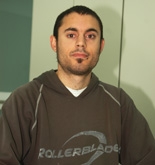Centro de Desarrollo de Sensores, Instrumentación y Sistemas
Universitat Politècnica de Catalunya
Shaping light to your needs




Actualidad
27/07/2012
volver
Miguel Ares recibe el Premio Extraordinario de Doctorado
Miguel Ares Rodríguez, investigador del CD6 ha recibido el Premio Extraordinario de Doctorado 2012, otorgado por la UPC. La tesis titulada "Técnicas de Reconstrucción y Compensación activa de Frentes de onda Complejos" ha sido dirigida por Santiago Royo y se ha desarrollado en el marco de los proyectos "Óptica adaptativa sin sensor y de alta velocidad aplicada al desarrollo de nuevas aplicaciones metrológicas" y "Desarrollo de nuevas aplicaciones metrológicas a escala micro y nanométrica basadas en técnicas de óptica adaptativa", ambos financiados a través del Plan Nacional de I+D+iAbstract:
The continuous improvements of optical design tools and manufacturing technologies of free-form optical elements, allow the creation of new complex-shaped lenses that improve the performance of traditional optical systems and make possible new optical applications. The quality of fabrication of complex-shaped lenses depends on the possibility of measurement of the shape along the manufacturing process. Moreover, the measurement of the shape of fabricated lenses is a usual quality control process conducted by the manufacturing industry to ensure the quality of commercial lenses. The measurement of complex-shaped optical surfaces has been usually done with mechanical contact stylus, to get higher resolutions within the larger dynamic range required. However, stylus devices have important drawbacks as a slow measurement speed due to make a point by point measurement, and specially the risk of damage of extremely polished surfaces of the lenses due to the drag of the stylus across them. As opposed to those mechanical contact devices of measurement, there are several non destructive optical techniques like interferometry and deflectometry based on the Shack-Hartmann sensor of spherical microlenses, which are much faster due to make a full-field measurement in a single shot. Despite this advantage, these two techniques have a more limited dynamic range of measurement than stylus devices, which does not allow to measure most complex-shaped lenses. Therefore, solutions to extend the dynamic range of those full-field optical techniques are needed. Otherwise, once an optical element has been tested, it is required to finally reconstruct its shape from the discrete data obtained in the measurement. In the lenses’ field, the modal Zernike representation is commonly used to reconstruct the shape. However, to describe complex shapes with steep local changes, zonal representations fit better. Among them, it must be mentioned the B-Spline representation, which is used by the ophthalmic lenses’ manufacturers in the design and modelling of complex progressive surfaces of lenses of this type. The current thesis describes various optical solutions to measure and represent the shape of commercial complex-shaped lenses, particularly applied to progressive addition lenses personalized to the user.
Extranet
CD6 Centro de Desarrollo de Sensores, Instrumentación y Sistemas
Rambla de Sant Nebridi, 10 · 08222 · Terrassa (Barcelona)
Rambla de Sant Nebridi, 10 · 08222 · Terrassa (Barcelona)

